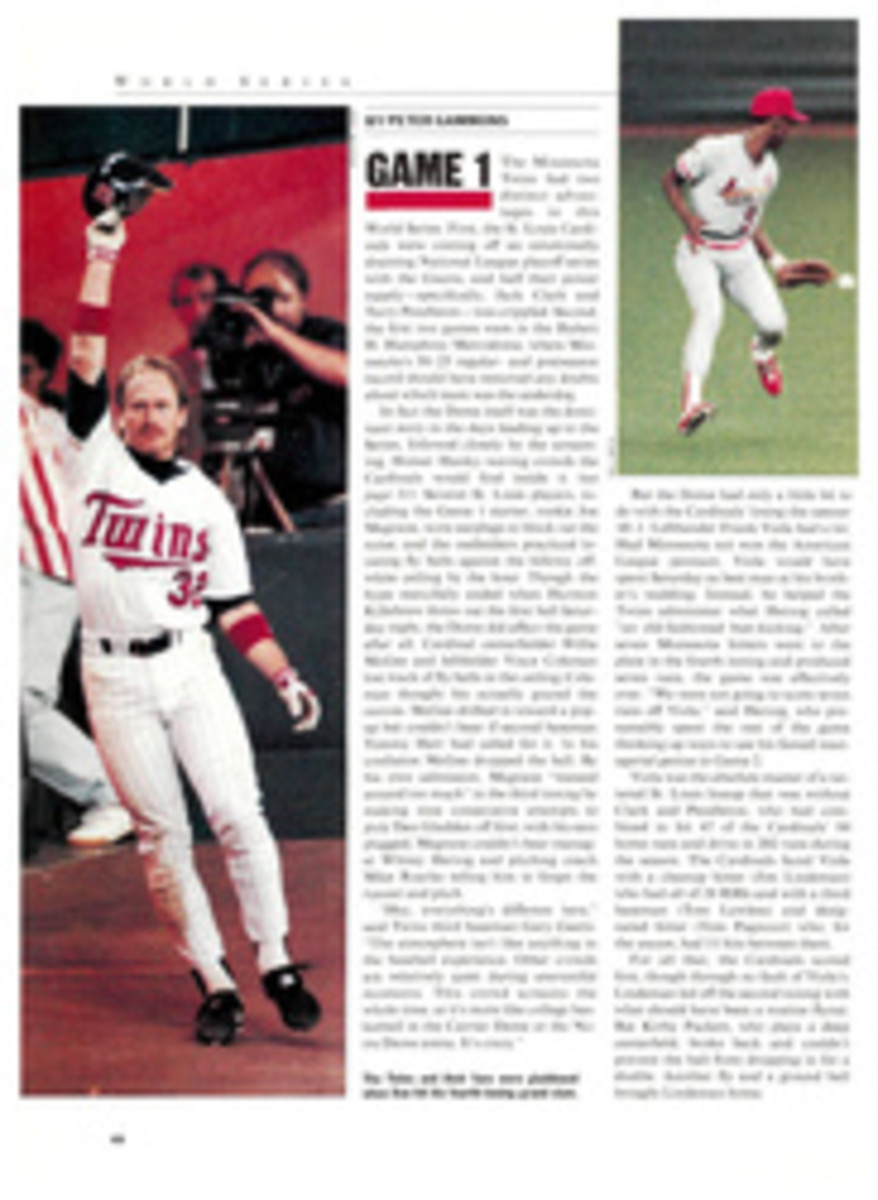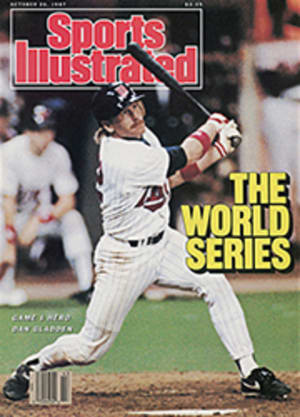
THE TEEN DREAM WHO COULD WAKE UP U.S. TENNIS
Andre Agassi is an amalgam. His father emigrated from Iran but Andre's a native of Las Vegas. Emmanuel Agassi—called Mike these days—was a boxing champion, but Andre's game is tennis. On the court, he seems a curious mix as well. He's right up-to-date in grooming—we'll get to the haircut in a second—but he plays with old-time decorum. Remember when tennis players expressed joy instead of fist-pumping intensity? Remember when they applauded their opponents' best shots? Remember when they smiled? Agassi does all that. He's a throwback.
But to see him is to think of MTV. The kid—there's nothing else to call him, he's a 17-year-old kid—has a teenage hipster's style and swagger. He has a killer smile. He looks like he might arrive for matches by skateboard. He has big brown eyes that drive the girls wild. And the hair. The hair is...perfect. Not Ollie North-perfect but teen-dream-perfect. It's long, with brown roots topped by blond, and it flows in the back into a waterfall that rushes three inches over the collar of his tennis shirt. And—hey, mom, chill out—that's this year's conservative style. Last year the 'do was lined with neon red streaks. Agassi looked like the Cowardly Lion's rebellious cub.
"There's no reason for the hair—I'm not saying anything with it," says Agassi. "I just do it this way 'cause I like it." Whenever Agassi tosses his mane about, teenybopper hearts stop. John McEnroe, his hairline receding by the match, must cringe.
There's more to Agassi than hair. In fact, another facet of the amalgam is that he's quite different from his image. He's not a punker and he doesn't want to be a teen idol. "Why idolize anyone?" he asks in his quiet, contemplative way. "I don't." He doesn't travel with a brat pack but with his older brother, Phil, who keeps the precocious pro sane on the grinding tour. When Agassi reads at all he reads the Bible. When he listens to music he chooses low-key James Taylor and disdains the Bon Jovis of his generation. "I'm nothing like the image." he says. "I'm not at all like the hair." When Agassi is home in Las Vegas, he's not a Vegas kind of guy. He doesn't go out, even to movies. He has no steady girlfriend. He sleeps 12 hours a night. "What I do is just relax." he says. "I'm casual, real mellow. I'm personal with my life. I have limited friends and a love for my family."
If Agassi isn't what he seems, his tennis game is exactly what it appears to be. It's a forehand. He stands most often at the baseline and hits this ferocious slingshot that's unlike any other on the tour. Every bit of Agassi's 5'10", 150-pound frame—and every one of the 80 pounds of pressure on his racket strings—is behind that shot. "In the juniors my forehand was my weaker side," says Agassi, looking back at the not-too-distant past. "Guys always played to my forehand. So I hit more and more of them, and then I started belting them. One day, I had the forehand. Sometimes, I really explode on it." Last season when McEnroe played Agassi for the first time he said, "No one's ever hit the ball that hard against me."
That comment was made after a quarterfinal match at the Volvo International, a 64-player tournament in Stratton. Vt., that had 1986's strongest field outside a Grand Slam event. Agassi had received a wild-card entry because he was a flamboyant-looking 16-year-old with the audacity to turn pro. When he appeared on court, giggles and snickers floated through the north-country hills. Three days later, after Agassi had run Tim Mayotte and a couple of others into the ground, the snickers had subsided.
But everything went south from Vermont. After reaching a ranking of 56, Agassi fell to No. 90. He reached a nadir this summer at a tournament in Washington, D.C. when he lost 6-0 in the third set of a first-round match against Patrick Kuhnen, ranked No. 106.
"That was a tough period," Agassi says. "Things weren't going right for me. Then I played an exhibition against Michael Chang, who's only 15. He was giving me a rough time—I just couldn't believe it. You don't want to lose to someone younger than you; it's an ego thing. I finally got my head straight and beat him. That match got me back on track."
Agassi then headed back to Stratton, the site of his big-time breakthrough a year earlier. This time he beat Wimbledon champ Pat Cash in straight sets and met Ivan Lendl in the semis. Their forehand-to-forehand battle was memorable. Lendl, serving hugely, knocked Agassi off the court in the first set. Then Agassi relaxed and started whaling from the forehand side. Lendl was shaking his head as the ball buzzed by, a full two feet from his outstretched racket. The spectators went wild as Agassi took the second set 7-5. "Arriba! Arriba!" they shouted. "An-dre, An-dre!" But Lendl changed his tactics in the third set and began hitting to Agassi's backhand. It worked. Lendl broke twice to win 6-3.
"He sure is a kid," said Lendl afterward. "It's amazing how long your hair can grow at 17. But, yes, if he plays the way he does right now, he could be Top 20." Agassi is wary about pushing too quickly for higher ground; he did that once. "When I beat Mayotte last year I thought I should be number 12 in the world," he says. "I thought I should beat most of the players, and I paid for that. It's not that easy. I'm smarter now. I'll take it a match at a time."
How far will patience and a forehand take him? To judge by his upbringing, as far as he wants to go. Agassi's dad, who boxed for Iran in the 1948 and 1952 Olympics and is now a showroom captain at the Bally's-Las Vegas Hotel Casino, tells a cute-prodigy/pushy-parents story. "Before he could walk he would sit in his high chair and I would give him a very small Ping-Pong paddle. I'd tie a balloon on the chair and blow it at him. He'd hit it back over and over."
A few years later Agassi would hit for hours against the playroom wall. "Finally he'd get tired," says his father. "He'd put the ball under his racket and use it as a pillow and take a nap. Then he'd wake up and start to hit again."
Such early diligence, plus lessons from his dad on the backyard court, made Andre a tyke to watch. When the pro tour came to town each year, says Agassi, "people would always stop by and check me out." He was a local legend. On Andre's fourth birthday he hit some with Jimmy Connors, and when he was eight he rallied with Bjorn Borg. One person he rarely plays is his brother-in-law, Pancho Gonzales, who is married to Agassi's older sister, Rita. "He's always too lazy to get out on the court," says Agassi.
One worrisome note about Agassi is that he's a die-hard Bollettierian. At 13 Agassi left home and junior high—"Me and school never got along"—and went to Nick Bollettieri's Tennis Academy in Bradenton, Fla. He remains a Bollettieri disciple and defender. "It bothers me when people talk bad about a guy they don't really know," says Agassi.
What people say is that Bollettieri baseline-bound supernovas don't have complete games and are predestined to burn out. Past Bollettieri wunderkinder like Jimmy Arias, Aaron Krickstein and Carling Bassett have all had fine careers, but none has lived up to world-beating expectations. Agassi is aware of this. "You know, people say Nick doesn't teach volleys," he says. "But it's just that Jimmy and Aaron weren't interested in volleying. Nick would help them if they wanted. I'm trying to come in more now, and Nick's helping. I don't want to learn after it's too late. That's what happened to Aaron."
Agassi already possesses some all-court talent, but he needs to develop an offensive shot from the backhand side and add some oomph to his serve to go with that lethal forehand. He's working particularly hard on the serve right now, and it showed last month in an Americans-only event on Amelia Island. Hard-hitting Robert Seguso was unable to attack aggressively and fell 6-1, 6-2 to Agassi in the semis. Then Jimmy Connors, who's had the best year of any American player, was trailing 4-3 in the finals when he had to retire because of the 100-degree heat.
Inevitably, Agassi is being pegged as one of the saviors of U.S. tennis. He tries to keep himself removed from all that. "You can learn from others' mistakes. What I've learned from Jimmy [Arias] and Aaron is that it can mess you up if you worry about everybody hoping for the next great American player. What people want to think and what they want to hope is their business. I'm going to try to play the way I want to play."
That way is fun to watch. Agassi jumps, spins and fools around during matches. He has charisma and knows how to work an audience in high Vegas style. Tennis could use some lightness, playfulness, charm and good humor today. It could use Agassi.
TWO PHOTOS
RED MORGAN
Bollettieri, accused of producing baseliners only, has Agassi working on his volley (left), but the forehand remains the kid's cannon.
PHOTO
MANNY MILLAN
Agassi won the crowd's approbation at the '87 Volvo.

